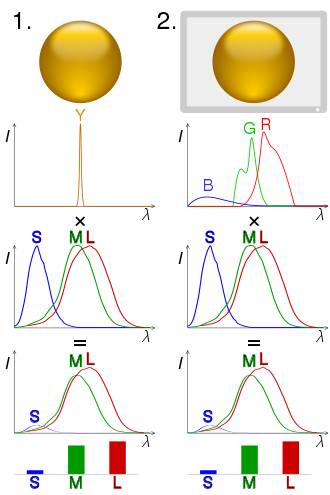Metamerism Anti-Counterfeiting Technology
In colorimetry, metamerism is a perceived matching of colors with different (nonmatching) spectral power distributions. Colors that match this way are called metamers.
A spectral power distribution describes the proportion of total light given off (emitted, transmitted, or reflected) by a color sample at each visible wavelength; it defines the complete information about the light coming from the sample. However, the human eye contains only three color receptors (three types of cone cells), which means that all colors are reduced to three sensory quantities, called the tristimulus values. Metamerism occurs because each type of cone responds to the cumulative energy from a broad range of wavelengths, so that different combinations of light across all wavelengths can produce an equivalent receptor response and the same tristimulus values or color sensation. In color science, the set of sensory spectral sensitivity curves is numerically represented by color matching functions.
Sources of metamerism
Metameric matches are quite common, especially in near neutral (grayed or whitish colors) or dark colors. As colors become brighter or more saturated, the range of possible metameric matches (different combinations of light wavelengths) becomes smaller, especially in colors from surface reflectance spectra.
Metameric matches made between two light sources provide the trichromatic basis of colorimetry. The basis for nearly all commercially available color image reproduction processes such as photography, television, printing, and digital imaging, is the ability to make metameric color matches.
Making metameric matches using reflective materials is more complex. The appearance of surface colors is defined by the product of the spectral reflectance curve of the material and the spectral emittance curve of the light source shining on it. As a result, the color of surfaces depends on the light source used to illuminate them.

Illustration of colour metamerism:
In column 1, a ball is illuminated by monochromatic light. Multiplying the spectrum by the cones' spectral sensitivity curves gives the response for each cone type.
In column 2, metamerism is used to simulate the scene with blue, green and red LEDs, giving a similar response.

